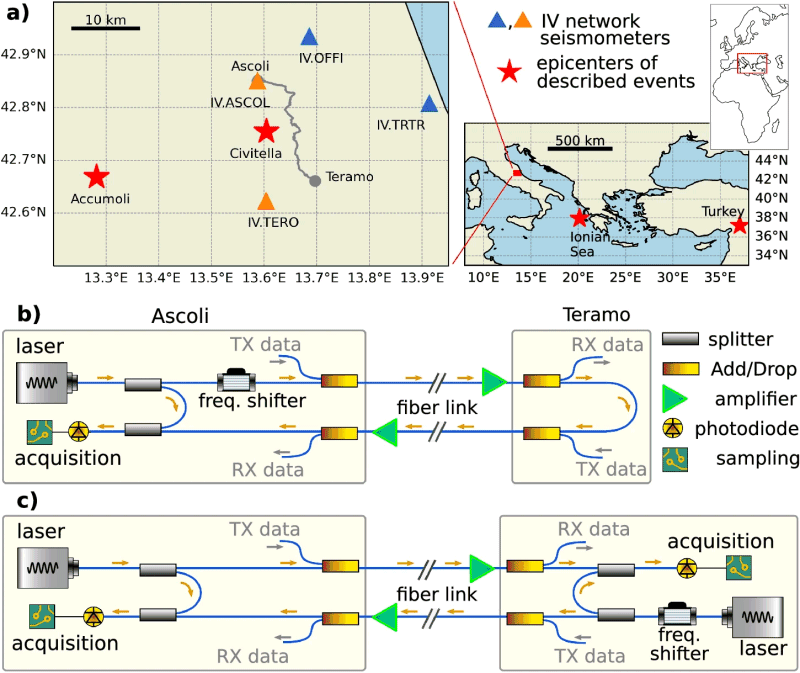Open Fiber announces today that it has obtained a prestigious recognition as part of a scientific project launched four and a half years ago. Is called BETTER and is short for Measuring Earthquakes signals Gathered with Laser Interferometry on Optic Fibers. Strengthened by its widespread network in optic fiberthe wholesale telecommunications operator – in collaboration with National Institute of Metrological Research (INRiM) e National Institute of Geophysics and Volcanology (INGV) – explained how he is also using it to detect earthquakes and precisely identify the characteristics of seismic waves.
We were talking about the possibility of using optical fiber to monitor earthquakes in October 2021: after all this time, following the encouraging results obtained by Open Fiber, INRiM and INGV, the well-known scientific magazine Nature published the all-Europen study. The favorable opinion of an authoritative magazine such as Naturewho submitted the results achieved by the experts to peer-reviewconfirms the intersectoral interest in the MEGLIO project.
How fiber optics detect earthquakes
In our country, seismicity is constantly monitored thanks to a dense network of sensors, managed and periodically updated by INGV. Fiber optics, the fastest and most reliable electronic communication tool in circulation today, allows us to take a step forward in this sector too, offering data more quickly and precisely.
The FTTH network (Fiber-to-the-Home) created by Open Fiber turns into a precious tool for surveying the territory, supporting and complementing conventional sensors.
As we explained in the article presented previously, Open Fiber collaborated with partners to create a seismic observatory which uses a pair of Open Fiber optical fibers deployed between Ascoli Piceno and Teramo.
The image is taken from the article that appeared in Nature.
A laser signal, made to flow in the fiber transmission medium without interfering with normal data traffic, allows measuring the microscopic elongations caused by any seismic vibrations through a particular interferometric technique developed by INRiM.
During a two-year trial, several dozen seismic events have been recorded, from the most disastrous, such as the earthquake that occurred in Turkey in February 2023, to those that are almost imperceptible (with a magnitude less than 2). The in-depth analysis of the acquired data, orchestrated by INGV, confirmed the validity of the recorded data and the possibility of using the technique underlying the MEGLIO project as monitoring tool permanent and capillary.
Laser interferometry for seismic monitoring: a real revolution
As mentioned previously, theinterferometria laser is a technique that uses laser light to measure small changes in length. When applied to seismic monitoring, laser interferometry can detect microscopic changes in cable lengths caused by earthquakes, offering a remote and precise method for monitoring seismic events of various magnitudes.
The cable sensitivity as an earthquake detector it has been the subject of specific evaluation, highlighting the possibility of detecting weak events even in noisy and densely populated environments. Furthermore, the probability of detecting medium-magnitude earthquakes in local areas was analysed, highlighting greater detectability in the direction transverse to the cable.
The study published on Nature also focuses on the importance of comparing the measurements returned by fiber cables and those obtained by conventional seismometers. The two types of recording differ both in the nature of the measurement (optical phase with respect to the ground speed) and in the measurement scale (distributed deformation with respect to local quantities): the experts therefore had to consider conversion metrics adequate.
MEGLIO, the first of a series of projects by network sensing which see Open Fiber as the protagonist
Francesco Carpentierihead of Transport Engineering at Open Fiber, observes that the publication on Nature of the results achieved with the MEGLIO project, confirms the interest and appreciation of the scientific community for the work carried out so far. “This is the first of a series of projects network sensing which we are working on and pioneering. Optical fiber is the enabling element of the digital evolution of our society, and Open Fiber, as a wholesale only operator, makes its network available to contribute to the development of an important area for our security such as seismic monitoring“, added Carpentieri.
Davide Calonico, Head of Quantum Metrology Division INRiM points out that “the publication strengthens the Europen presence in a line of research that is attracting increasing interest at a global level, and represents an important basis on which build further innovation“.
André HerreroFirst Researcher at INGV, underlined that: “uAn important mission of INGV is the monitoring of the national territory for earthquakes, volcanoes and tsunamis. The results emerging from this study open new frontiers in monitoring the seismicity and vulnerability of our cities, reaching our homes through the already existing fiber optic infrastructure. What makes this technology Like this promising are two key elements: its complementarity with current instrumentation and its sustainability thanks to the reuse of existing infrastructure. By combining sensorial capacity with data transport capacity, fiber optic monitoring can become a crucial player in prevention andearly warning in case of seismic events o tsunami“.


